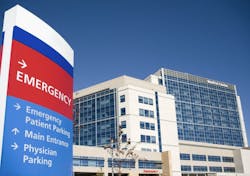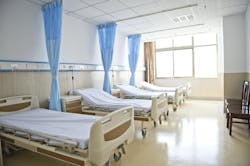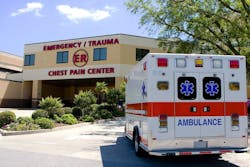How improving emergency department design leads to greater hospital efficiency
Improving both throughput and the physical environment in the Emergency Department (ED) is a top priority for many hospital administrators and facility managers. The ED (on a hospital campus or free-standing) is often an initial access point into a system-of-care, the start of a hospital admission, and a significant touch-point for patient care.
In many master plan studies over the last several years, hospital leaders have identified improvements to their ED as a top priority.
How many times have you heard, “form follows function”? Unfortunately, many providers have the adage flipped thus, poor function begets poor form. This can result in:
- Longer wait times
- Extended care processes
- Patients leaving EDs without being seen or against medical advice
- Low utilization of rooms
- General dissatisfaction amongst consumers and providers
Efficient throughput is critical to getting a patient to their desired destination (e.g. home or inpatient bed) as quickly as possible. “Door to Disposition” time is one of the most scrutinized statistics in acute care environments.
Efficient operations result in shorter wait times, quicker diagnosis and care plans, maximum utilization of high-cost human and physical resources, and overall better patient experiences and patient satisfaction scores. Many members of the community evaluate their ED experience by its wait time. Do you recall billboards that promote current wait times for your local ED? It may seem odd that consumers would decide on going to an ED based on published wait times. After all, if it is a true emergency then they should get to the closest ED quickly. However, consumers use EDs for a variety of non-life-threatening, non-emergent reasons and want to know if they can be seen quickly. Once they are admitted, rapid diagnosis, effective treatment, and efficient progression through the process is not only required but expected.
ISSUES AND SOLUTIONS
Over the years, we have worked with many clients seeking to improve their EDs. Some common themes have emerged when questions are discussed concerning issues that need to be addressed and recommended improvements. These questions are both operational and physical, and can be directly linked. Examples include:
- Addressing capacity issues due to increased volume
- Improvements in door-to-doctor and door-to-disposition time
- Strategies to deal with low-acuity (urgent care / non-emergent) patients
- Increase in behavioral health patients
- Improvement in triage functions
- Improvement in staffing ratios
- Managing the “observation / clinical decision” patient
- Addressing the lack of privacy
- Addressing room sizes
- Improvement in support space and “blind spots” in the ED
So, what is being done to address these issues? Operationally, taking a “lean process” approach to addressing throughput is a tactic that will allow you to address the root causes of poor patient flow. Most organizations assume that adding treatment rooms will be the cure to capacity issues in the ED. While this may be the case in some instances, it typically does not solve all problems, but rather addresses a symptom of a larger problem. Many capacity issues can be filled with “no-build” solutions. Start the discussion by asking questions, analyzing data, and streamlining all processes.
To quickly assess how an ED might be performing, review the visits per room per year as a throughput metric. A typical range is from 1,300 – 2,000 visits per room per year. A mid-point of around 1,500 visits per room per year is an average throughput planning standard that is routinely utilized. Operating at the high-end of this range is typically not sustainable at much above 2,000 visits per room per year and a physical expansion or diversion of volume may be required. Operating at the low-end of the range allows for growth of volumes or use of space for other functions. Some facilities operate within this range, but still have issues with overcrowding or use of “hallway beds” regularly. If this is the case, then patient flow through the ED requires scrutiny.
Other metrics investigated and average benchmarks include:
- Triage time (5-8 minutes)
- Arrival to room (30-40 minutes)
- Arrival to provider (~ 1hour)
- Overall average visit length (220 – 240 minutes)
Of course, these metrics may vary with acuity and a variety of other factors (e.g. lab and radiology results turnaround time) and are impacted by downstream bed availability when an ED patient is admitted.
PLANNING AND DESIGN
When evaluating programming and design of an ED, following a process design or “Lean Led” approach that incorporates a lean planning, space programmer, and designer to meet with an ED focused multi-disciplinary user group is recommended. The lean planner should drive the process by first seeking to eliminate “waste” from the flow of patient care activity. A thorough investigation of all processes, from patient arrival to disposition, should be explored to streamline flow and ensure that the value stream drives standard work and space.
In today’s ED environment, a way to increase capacity is to shift the location of care for lower acuity, non-emergent conditions. As the shift towards value-based reimbursement continues, access to urgent care, primary care, and extended care options will continue to be valuable tactics to managing crowded emergency departments. If a provider can redirect lower acuity patients and better manage their overall care, then the potential to reduce overall ED visits will surface. This will afford the opportunity to streamline the provision of care for the higher acuity patients appropriate for the ED.
Once the value-stream is refined, staffing and designing the ED appropriately becomes the priority to ensure patients are cared for efficiently. ED designs are trending towards spaces that maximize standard work, including “universal care” rooms. That trend relates to most rooms in the ED, with the exception of the highest acuity trauma / resuscitation rooms. They are being sized to care for a variety of patients. Typical room sizes range from 140 and 160 net square feet and are all private in nature. Most organizations are designing rooms that incorporate full glass front-walls with “breakaway” doors to maximize privacy, allowing for quiet patient care with the ability to be broken-down in the event of a code situation. To save on capital cost, some organizations are implementing private rooms with three (3) walls and a curtain for the front-wall. This can balance privacy, accessibility, and cost; but somewhat compromises privacy.
Designing the core ED around optimal flow requires direct visualization of patient treatment rooms from a team and support core. Minimizing hard wall elements, such as stairwells and mechanical risers, in these support cores will maximize the ability to directly view patient rooms without blind spots. Think of an ideal ICU layout, that is how you want ED staff to be able to view patients. However, ED’s are usually larger than the average 12 bed ICU (or 12 bed ICU zones). An ED with 50,000 annual visits may have around 32 patient care rooms, too large for one set of staff resources. Thus, breaking down the ED into linked and continuous “pods” will ensure best use of resources. In this environment, think of an inpatient unit designed with patient rooms on the perimeter and support core in the center with each set of 8-rooms designed as a care team pod.
Each care team in this arrangement would consist of at least:
- 1 Provider (physician or physician extender)
- 2 RNs
- 1 Tech
- 2-3 additional personnel (clerical, pharmacist, work area, etc)
Support elements could be shared between 2 or 3 pods and those would include:
- Family consult room
- Medication room / area
- Nourishment area
- Clean supply and soiled utility rooms
- Point of Care Testing alcove
- Pneumatic tube
- Equipment and linen alcove / storage
- Crash cart
- Patient toilet(s)
Departmental support for the entire ED includes:
- Decontamination area
- Hazmat storage
- Ambulance entry / patient intake zone
- EMS support
- Imaging
- Staff support (break area, lockers, lounge, toilets / showers)
- Administrative offices and conference area
- Public and intake (waiting, registration, security, triage, vending)
Other operational and facility improvements being implemented include:
- Treat in triage: If redirection to a less-acute environment is not possible, for less acute patients, staff the triage area of the ED to function as a track in the ED. These stable patients (Emergency Severity Index / ESI level 4 or 5) require minimal, if any, diagnostic and lab testing. Patients can be seen in an upright bed / recliner either in a private environment (preferred) or within a ward of upright curtained cubicles without ever going back into the more acute “lay down” ED environment. The key is being able to staff this fast-track type zone with a dedicated staff led by a physician or physician extender as appropriate. Sufficient volume, between 10,000 – 15,000 annual low acuity visits at a minimum, is required to ensure efficient use of resources.
- Direct rooming: Once the patient arrives and passes through a brief triage and quick registration process where only the most primary information is collected, the patient is directed to the appropriate room. Within this room, the care process begins which includes full registration. A floating registrar completes the registration process with the patient and family member, collecting information as required on a mobile device (e.g. workstation on wheels, tablet, or handheld). The patient’s vital signs, assessment, blood draw and care all take place in the treatment room. The only time a patient leaves the treatment room is if they need to go to a specialty diagnostic room such a CT scanner or radiography/fluoroscopy (R&F) room. It should be noted that imaging modalities (CT, R&F, Ultrasound, etc.) should be either part of or directly adjacent to the ED to allow for easy, quick transport and rapid results.
- Behavioral Care Pod: EDs nationwide struggle to care for a growing number of patients presenting at EDs with a behavioral health condition. Many times these patients have either a primary or secondary behavioral health diagnosis coupled with a medical comorbidity. To deliver the care to these patients in the most appropriate manner and to ensure patient and staff safety, many EDs are implementing distinct behavioral health pods within the ED. These pods are in dedicated zones where the rooms and support elements are designed with patient safety as the primary concern. These areas should be secure, and located on the perimeter of the ED. Some hospitals with a small but consistent demand of behavioral health patients have even created dual-use units that function as both ED and inpatient behavioral health rooms appropriate for short stays.
- Clinical Decision Unit / CDU: Most often, additional testing and extended assessment is required prior to making an admission or discharge decision. If there is critical mass (at least 8 to 12 patients on average) moving patients to a separate CDU adjacent to the ED could be considered. These CDUs, like the low-acuity fast-track areas, should be separately staffed with dedicated care personnel that can continually monitor and assess patients in a more intensive fashion. This allows the standard ED treatment room to be released for cleaning, turnover, and acceptance of the next appropriate ED patient. By establishing a CDU, the standard work and flow of the general ED is preserved, thus maximizing patient throughput. The CDU patient is also cared for in a standard way for this particular population of patients allowing for an appropriate and timely disposition decision.
- EMS / Transport Receiving and Triage Zone: One bottleneck frequently encountered is the patient transport intake area of an ED. Many times, EMS personnel, with a patient on a transport stretcher, end up in the middle of the ED in a high traffic zone while they are handing off the patient to ED personnel. This can be distressing and distracting for the patient, surrounding patients, family members, and staff. Thus, incorporating a functional and dedicated zone to allow for private intake of EMS patients is recommended. Placement adjacent to or back-to-back with the walk-in triage zone, but away from public view, will allow this area to function as a control center for the ED and for staff to intake both walk-in and ambulance arriving patients.
CONCLUSION
Moving from volume to value-based care and reimbursement models requires a different approach to managing patient care and minimizing ED visits. With a population health-based approach, health systems can reduce the volume of ED patient visits overall. Other strategies to manage patient populations include up-right, fast-track areas; dedicated behavioral health beds; universal and standard care pods; and clinical decision units.
In order to improve overall flow, consider taking a lean approach to assessing processes from arrival to disposition and all steps in between. Consider ways to reduce waste throughout the entire patient care process then standardize processes and spaces to fit the best value-stream. Next, design spaces in a deliberate and standard way to best fit the ideal processes. Consider piloting these improvements in one zone of the ED as a living operational and physical mock-up, then make adjustments prior to implementing across the entire ED.
Finally, visualize and hear the ED environment through your patients’ eyes and ears. Patients’ and families’ stress levels are running high during a care episode (as are your staff’s during peak times). By ensuring privacy and dignity in a quiet, healing environment, you are sure to make the experience as pleasant as possible, improve overall patient care outcomes, ensure high satisfaction scores, and improve the overall patient experience.
About the Author: Curtis Skolnick, Managing Director, CBRE Healthcare, has over 24 years of healthcare strategic and facilities planning experience and leads CBRE Healthcare’s Consulting Solutions team. His expertise lies in strategic master facilities planning (SMFP), project launch, launch gap analysis, market modeling, system and new business development, strategic planning, capacity analysis, CON preparation, operational and space programming, and government and regulatory affairs planning. As well as being a skilled facilitator and consultant, Skolnick's provider experience gives him a unique understanding of client issues and needs. In his role at CBRE Healthcare, he utilizes his background in planning together with his analytical, organizational and facilitation skills to provide a strategic focus and direction to CBRE’s Healthcare clients.






